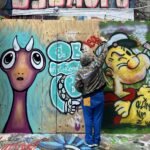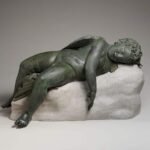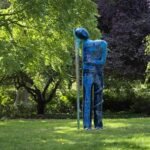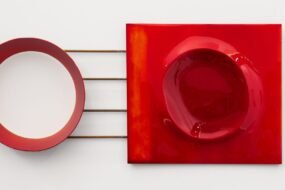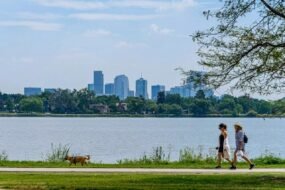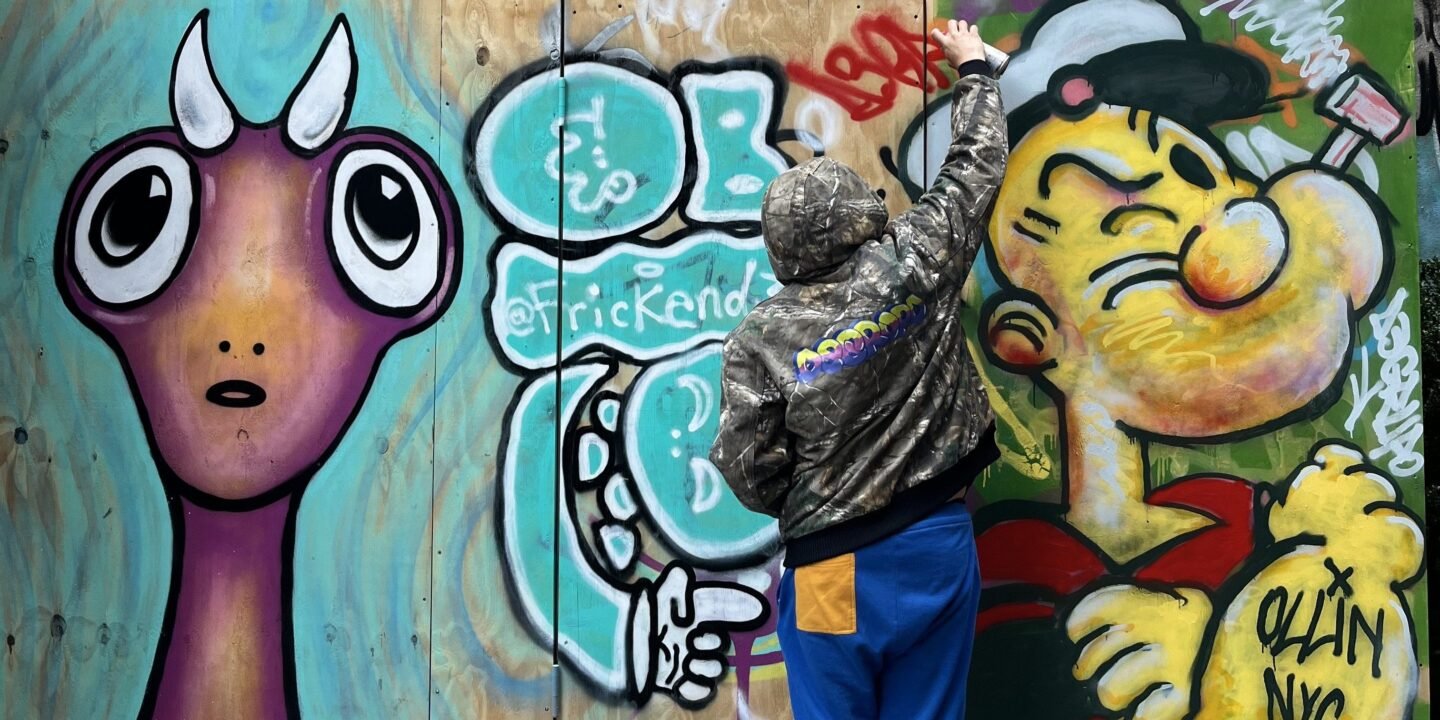

Down on the Bowery, the New Museum’s minimalist stacked-box look is the oddball in an architectural lineup that includes surviving 19th-century buildings like William S. Burroughs’ bunker and the venerable Bowery Mission. Today, workers are putting the finishing touches on the museum’s glimmering $82 million 60,000-square-foot expansion, which pushes the modernist language further with its angular, faceted form.
On a recent day in the alley behind the museum, finishing touches were also being made as Degrupo, one of New York City’s most prolific graffiti writers, stood on his toes to tag a plywood barrier in red spray paint. It was the latest addition to Freeman Alley—Lower Manhattan’s graffiti ground zero—which for decades has been an organic open-air gallery for a far-flung community of outlaw artists whose work rarely finds its way into established art institutions.
Soon, a new portal linking the street with the elite will open behind that plywood barrier. When the museum’s expansion is done this fall, Freeman Alley will become the primary after-hours entrance to a new high-end artfully appointed restaurant inside the expanded museum. So before indulging in modern American cuisine and botanical cocktails, museum patrons will be confronted by the work of some of New York City’s premier graffiti artists in a dialogue between two art worlds that have historically existed in parallel.
“It’s everything together,” Degrupo said. “On one side, it’s good for us artists for exposure. People walk through and see us painting and see our art—that’s a good thing.” Then, considering the forces of commercialism and gentrification that have been pressuring the alley for years, he added: “Hey, corporate gonna do what corporate gonna do with the resources they have. But you never know, maybe one day we’ll be inside the museum.”


Both the museum and its new addition have their main entrances next to the Bowery Mission on Bowery between Rivington and Stanton Streets in New York’s Lower East Side. Freeman Alley—a dead end that runs parallel to Bowery—ends behind the mission.
In interviews with Observer, many of the artists who have for years claimed Freeman Alley as their turf agreed that the New Museum’s restaurant entrance represents opportunity rather than encroachment. Vewer, another prolific writer who has long curated a large portion of the Freeman Alley wall, embraces the institutional attention: “I think it’s great. Why wouldn’t you want more people to see your work, and especially people who are into art since they’re going to the museum?” he told Observer.
His perspective reflects a pragmatic understanding of property rights that might surprise those who romanticize graffiti culture’s outlaw ethos. “The fact is we don’t own those properties. And it’s funny because, among graffiti writers, there’s this naive, ignorant philosophy that the walls are ours. Truth is nothing is ours.” Having acquired his own property recently, Vewer has gained new appreciation for ownership: “I would be tight if someone hit my shit up.”
Zui, another writer who has been giving tours of the alley and watching its transformation for years, sees potential for symbiosis. “In theory—it’s a symbiotic relationship,” Zui said in an interview with Observer. He envisions the New Museum’s presence elevating the alley’s status: “If we can somehow accept that the New Museum is using the alley because of the art, but adding to the alley with their presence, it’s only going to make it better for us all in the street art community.”
In recent years, Freeman Alley has gained tremendous cachet among New Yorkers and others hungry for a taste of the art world’s outlaw underground and authentic guerrilla artwork displayed in the wild. The alley—every inch ablaze with layers of chrome and candy-colored spray-painted tags, stencil work, wheatpasted compositions and stickers by the thousands—has become a coveted backdrop for fashion shoots, music videos and Instagram campaigns. Celebrities spotted there recently: Taylor Swift, Bad Bunny and Dave East, to name a few.


Jimmy Wright, an artist with work in the collections of the Whitney and the Met, is Freeman Alley’s sole resident and its unofficial historian. Over nearly five decades, Wright has witnessed the alley’s evolution from a hangout for drug dealers, junkies and prostitutes into what he says he sees today: “slick, high-rise affluent Manhattan.”
The change came in stages. First Freemans Restaurant opened at the alley’s terminus 20 years ago. Then the UNTITLED Hotel shuttered its door on Bowery and carved out a courtyard entrance from the alley, simultaneously inviting graffiti artists to decorate the space in a calculated act of artwashing. In the past year, a luxury residential tower owned by UNTITLED’s proprietors was completed on the alley’s opposite side, accelerating the transformation.
While he sees the new restaurant entrance as the unavoidable next step in the commodification of the alley, Wright doesn’t expect it will do anything to narrow the gap between the fine art in the museum and the street art outside.
“It’s two different art worlds,” Wright told Observer, standing in front of his apartment, which overlooks the alley’s daily theater. “This isn’t 1978, with Keith Haring and Jean-Michel Basquiat. It’s a different art world, and these artists are not Jean-Michel Basquiat.”
According to city liquor license documents, the New Museum restaurant will operate from 9 a.m. to 1 a.m., serving patrons “modern American” cuisine. While the museum lobby provides daytime access, Freeman Alley becomes the sole entry point after hours—likely after 6 p.m. when the museum closes.
In an unusual move for an organization dedicated to treating alcoholics and drug addicts, mission president and CEO James Winans wrote a full-throated endorsement of the restaurant’s liquor license application. “I imagine The Bowery Mission’s endorsement of a liquor license may be surprising to the Board,” Winans wrote in a letter to Community Board 3. “The Mission has always assisted New Yorkers overcoming alcohol abuse and other addictive behaviors. As such, we have not typically written to you in support of new liquor licenses.”
In order to locate the restaurant entrance in the alley, the museum had to strike a deal to gain passage through the mission’s backyard. Although rumors circulate that the mission received $1 million for this access, financial details remain private. What’s clear is the strategic benefit to the restaurant: in addition to offering their patrons a glimpse of outlaw art, it also enables them to avoid direct encounters with the homeless who line up for meals daily outside the mission’s entrance on the Bowery.


The restaurant itself promises an artsy atmosphere, though nothing like the raw artistic energy outside its back door. Chef Julia Sherman will create “artful and visually striking” dishes with “bright colors and playful eating,” while artist Ian Cheng’s installation will anchor the bar area and designer Minjae Kim will provide custom furnishings. The wine list emphasizes natural selections from regenerative growers for conscious consumers.
Yet the gap between the indoor and outdoor art worlds remains vast. None of the artists working in Freeman Alley is likely to be a regular patron of the museum’s new dining establishment, where martinis and spritzes will flow while graf writers continue to work out back. The New Museum’s communications director Sarah Morris offered carefully measured responses when asked about this cultural intersection, noting that the institution is “thrilled for the New Museum’s expansion to be a continuation of that history in dialogue with the surrounding arts community—including those working on Freeman Alley.”
The museum’s outdoor programming plans focus on their new public plaza at Bowery and Prince Street, not Freeman Alley. A sculpture by Sarah Lucas will inaugurate the plaza, safely contained within institutional boundaries, while the alley will remain, for the present, an unregulated free-for-all.
Before the Freeman Alley access plan, the New Museum’s most significant engagement with street art may have come in 2022, when an artist known as Acer scaled the five-story Bowery facade, leaving a monumental tag three stories up. It was one of Lower Manhattan’s most audacious graffiti works, but the museum scrubbed it clean within 48 hours.
The museum says it remains “deeply rooted in the Bowery neighborhood,” but not everyone believes the restaurant door and the continued evolution of one of the city’s few true street art destinations is good for the alley. Optimo, another artist and long-time alley regular, sees the writing on the wall: “Freeman Alley has already become exposed; it’s time for change. People need to spread out more than just relying on one alley to get their art seen,” he told Observer.
Optimo’s words capture the fundamental tension: as Freeman Alley becomes increasingly institutionalized, its value as an authentic street art space could diminish. In that sense, the New Museum’s entrance represents both validation and co-optation.
The plywood over the door that will link the graffiti-covered alley with the curated corridors of the museum will disappear shortly, taking Degrupo’s work with it. Whether Freeman Alley becomes the scene of some kind of dialogue between art worlds or simply another example of cultural appropriation may depend on how both sides navigate this unprecedented arrangement. For now, at least, it seems both worlds stand to benefit from the adjacency.



